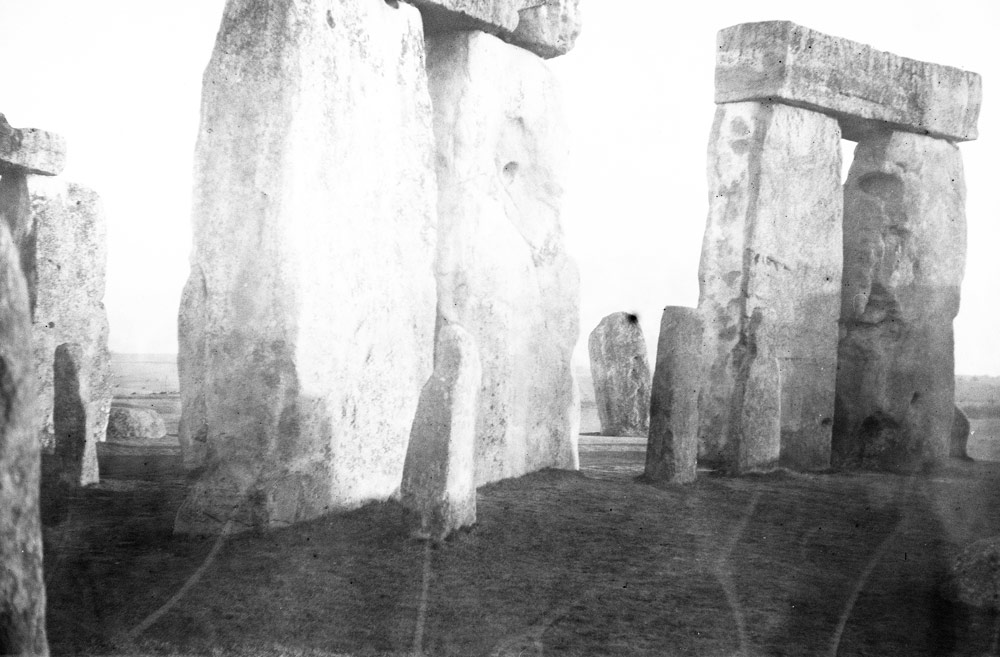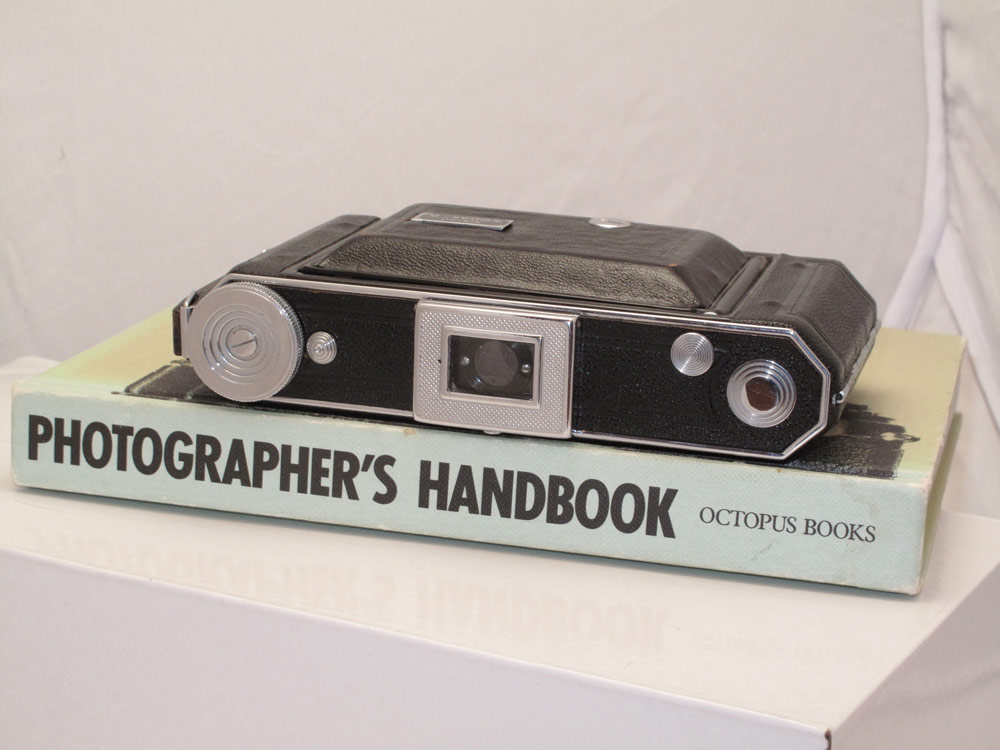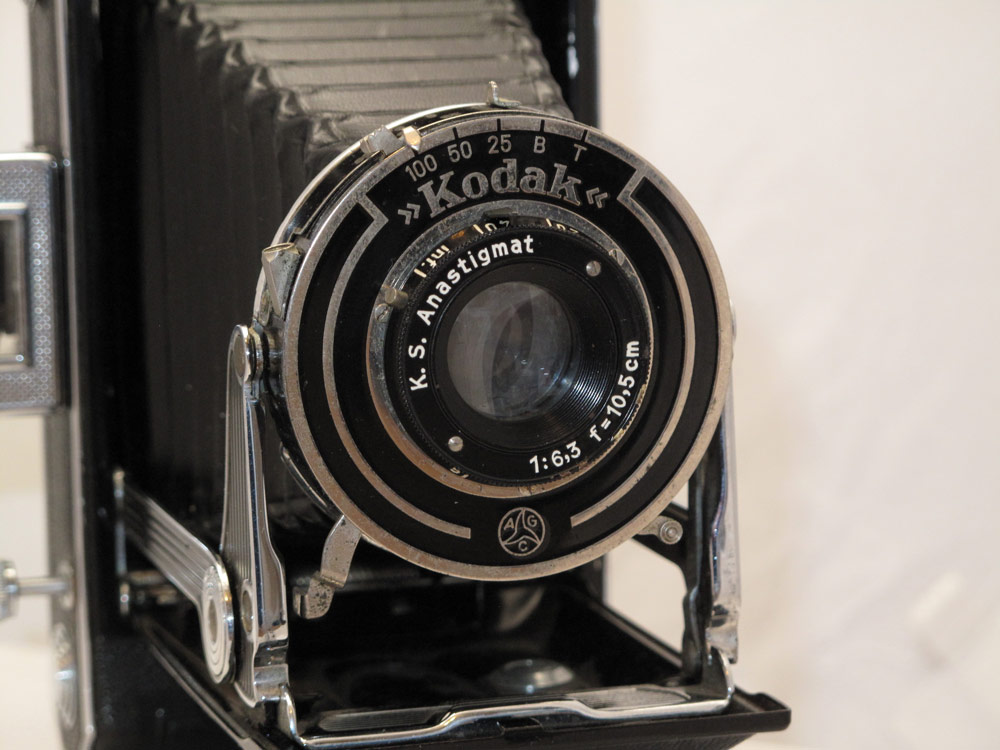Regular AP contributor Adrian Gray is a scientist by day and a keen collector of vintage cameras, particularly Kodak Brownies, the rest of the time. A chance finding of an old Kodak bellows film camera led him to a fascinating journey of discovery and a gutsy refurbishment project.
Stonehenge, sometime in the 1950s. A couple wander about the stones, stopping to take pictures with their old Kodak. At the end of the day the camera was put down with the film half-used, not to be used again, the film never finished. For whatever reason, it sat for decades with the bellows slowly crumbling. Then, around 2005, I spotted the attractive Kodak on a market stall in Oxford. Intriguingly I could see it had a film in, and decided to buy it despite the ruined bellows. I naively thought that I might be able to repair them but quickly realised that they were well past my ability to fix.

Found Kodak bellows camera © Adrian Gray
What about that film, though, would it have anything on it? At the end of an afternoon’s developing I carefully loaded it onto a spiral. Once fixed and washed I carefully unrolled the film and… wow! Two clearly identifiable images of Stonehenge, obviously a very long time ago. It was the first found film I’d found images on, and what images!

Shot of Stonehenge – found film discovered in Kodak bellows camera was developed after an estimated 50 year hiatus by Adrian Gray. Photographer unknown.
Fixing up an old Kodak bellows camera
The Kodak became a shelf queen until, in early 2022, I found a set of bellows I’d been given years before for a project I’d never been brave enough to attempt. In a moment of madness, I decided to use them, reasoning that the Kodak was in poor enough condition that it didn’t matter if I failed.
I learnt a lot about 1930s camera construction very quickly – the bellows are held in with a metal plate on the back, fastened to the camera body by bending over metal tabs, with just a length of black string as a light seal. It took guts I didn’t know I had to unfold the tabs, and plenty of brute force and ignorance too.

Found Kodak bellows camera © Adrian Gray
As I dismantled the struts holding the shutter assembly, I carefully counted the screws I removed – but suddenly had one more than I should have. Where was it from? I counted and recounted the possible places and, however many times I checked, there was definitely one screw over. It must have been snagged somewhere in the camera since it left the Kodak factory over 80 years ago. I didn’t return it – it now replaces a missing screw in another camera.
I had to remove the front plate of the new bellows with a scalpel and cut down the Kodak bellows back plate to fit the new, as the threaded holes for securing them to the shutter housing didn’t match up. I couldn’t unscrew the screws giving access to the shutter mechanism, though as I’ll never need to use the dead speed, 1/25th of a second, I can live with that. I filed down any damage to the film gate and gave it a liberal coating of matt enamel paint once I believed that I might make the camera usable again, which was quite late in the proceedings.

Close up of three-element f6.3 Anastigmat lens on found Kodak bellows camera © Adrian Gray
Towards the end of the rebuild, I had the idea of taking the camera back to Stonehenge and trying to replicate the photos as the first shots with the new bellows. I skinned up a roll of Fomapan 100 onto a 620 spool and loaded the camera.
In May 2022 I went to Stonehenge with the camera and took six photos. Since the originals were taken, access to the stones has been restricted so I couldn’t recreate the original views, but the site staff were delighted to hear the story of the camera (more so than their employers at English Heritage, who never replied).
The origins of the mystery Kodak bellows camera
The camera itself is hard to find out more about. It shares many features with the German-made Kodak Vollenda cameras of the later 1930s, but the strap says: “Manufactured by Kodak Ltd, London”, and the Vollenda range had faster lenses and better shutters than the three-element f6.3 Anastigmat in a three-speed AGC shutter this camera sports.
It was probably an affordable version for the UK market, although it does have unexpected features for a cheaper camera – the lovely shutter release button that pops up when you open the camera, and the two tripod sockets each filled by a slotted metal plug that unscrews to reveal the socket (and must have been horribly easy to lose). The struts, the folding foot, and the red window cover are also a high-quality combination of paint and nickel plating.
My best guess is that these are a product of Kodak’s “standardization” policy of the time, consisting of excising the word from every dictionary in the company and offering every camera body with a bewildering array of lenses and shutters.

Reconstruction of original shoot at Stonehenge on refurbished Kodak bellows camera © Adrian Gray 2022
Thankfully Stonehenge is easier to research and, like the camera, it has been restored. The views in the original photos altered long before the film was developed, with a trilithon being re-erected in 1958-9 and the hollow stone the man in the mac is stood next to being reinforced with concrete at the same time. So the camera was last used before 1958. The film, Ilford Selochrome, a “fast ortho film” of 30-degree Scheiner, approximately ISO80 and coincidentally discontinued in the late 1950s, must have sat with a latent image for almost fifty years before I developed it!

Stonehenge captured on refurbished Kodak bellows camera © Adrian Gray 2022
Things I’d do differently if I did it again…
Nowadays, I have a formula for developing found film that has economy of chemicals and labour. I use semi-stand developing for an hour in 1:100 Rodinal, rather than just using the last of whatever I’d used that day.
I’d check the sun’s position before getting to Stonehenge to avoid shooting into it. I also probably wouldn’t try a camera that I wasn’t sure was light-tight in bright sun, and I’m not sure I’d be brave enough to do another bellows replacement. I certainly wouldn’t try it with a better camera.
On the other hand it was very satisfying to finish, I have one less junk camera, and another old Kodak lives to fight another day!
Written by Adrian Gray
 AP reader Adrian is a scientist in the week . At weekends he likes to take photos of appropriate subjects with his worryingly large collection of antediluvian cameras. Should you meet a walker in the Lake District toting an ancient folding camera, it’s probably him.
AP reader Adrian is a scientist in the week . At weekends he likes to take photos of appropriate subjects with his worryingly large collection of antediluvian cameras. Should you meet a walker in the Lake District toting an ancient folding camera, it’s probably him.






